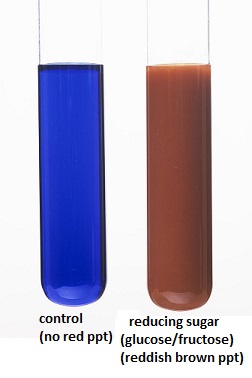What Is Fehling’s Test?
The Fehling’s test was developed by German chemist Hermann von Fehling in 1849. It is generally a test for reducing sugars and non-reducing sugars; and also a supplementary to the Tollens’ reagent test. The test can also be used to differentiate between water-soluble carbohydrate and ketone functional groups.
Objectives of Fehling’s Test
- To detect the presence of carbohydrates in a solution.
- To differentiate between reducing and non-reducing sugars.
Principle Of Fehling’s Test
Fehling’s test consists of a solution that is usually prepared fresh in laboratories. Initially, the solution exists in the form of two separate solutions which are labelled as Fehling’s A and Fehling’s B. Fehling’s A is a solution containing copper(II) sulphate, which is blue. Fehling’s B is a clear liquid consisting of potassium sodium tartrate (Rochelle salt) and a strong alkali, usually sodium hydroxide. During the test solutions A and B are prepared individually and stored.
The two solutions are later mixed in equal volumes to get the final Fehling solution which is deep blue. The deep blue ingredient is the bis(tartrate) complex of Cu2+. The tartrate tetra-anions serve as a chelating agent in the solution. If any aldehyde or sugar molecule is the test solution, they form a reddish-brown chelated compound with Fehling’s reagent. The formation of this reddish-brown precipitate is indicative of the presence of sugar reduction or an aldehyde group. For the Fehling reagent test, sugars such as glucose, fructose and lactose yield positive results.
Experiment
Reagent And Material Required
Reagent
- Fehling’s solution A: Dissolve 7 g of CuSO4.7H2O in 100 ml of water.
- Fehlings solution B: Dissolve 24 g of KOH and 34.6 g of potassium sodium tartrate in 100 ml water.
- Fehling’s solution: Mix equal volumes of both the solution just before use.
- Sample (5% Glucose, 5% Sucrose, 5% Fructose, 5% Starch, 5% lactose)
Material Required
- Pipettes
- Test tubes
- Test tube stand
- Water bath
Fehling’s Test Procedure
- Take 1ml of sample and put it in a dry test tube.
- Similarly, take 1ml of distilled water and put it in another test tube as control.
- Then, add 1ml of Fehling’s reagent (A and B) to all the test tubes.
- Heat the test tubes in boiling water bath for at least 5 minutes.
- Observed for the development of color in the test tubes.
Fehling’s Test Result Interpretation

- Positive Result: A positive Fehling’s test is indicated by presence of reddish-brown precipitate in the test tube. This confirms presence of reducing sugars ( glucose, fructose, lactose)
- Negative Result: a negative Fehling’s test is indicated by absence of reddish-brown precipitate in the test tube. This confirms absence of reducing sugars.
Uses Of Fehling’s Test
- It is used to differentiate between the presence of aldehydes and ketones in carbohydrates since, in this test; ketone sugars other than alpha-hydroxy-ketone do not react.
- Fehling’s can be used to screen for glucose in urine, thus detecting diabetes.
- Fehling’s test can be used as a generic test for monosaccharides and other reducing sugars (e.g., maltose).
Limitations Of Fehling’s Test
- The test does not detect aromatic aldehydes. The solution cannot differentiate between benzaldehyde and acetone.
- This reaction takes place only in an alkaline medium. In an acidic medium, the copper (II) ions would be stabilized and not easily oxidized, thus failing the reaction.